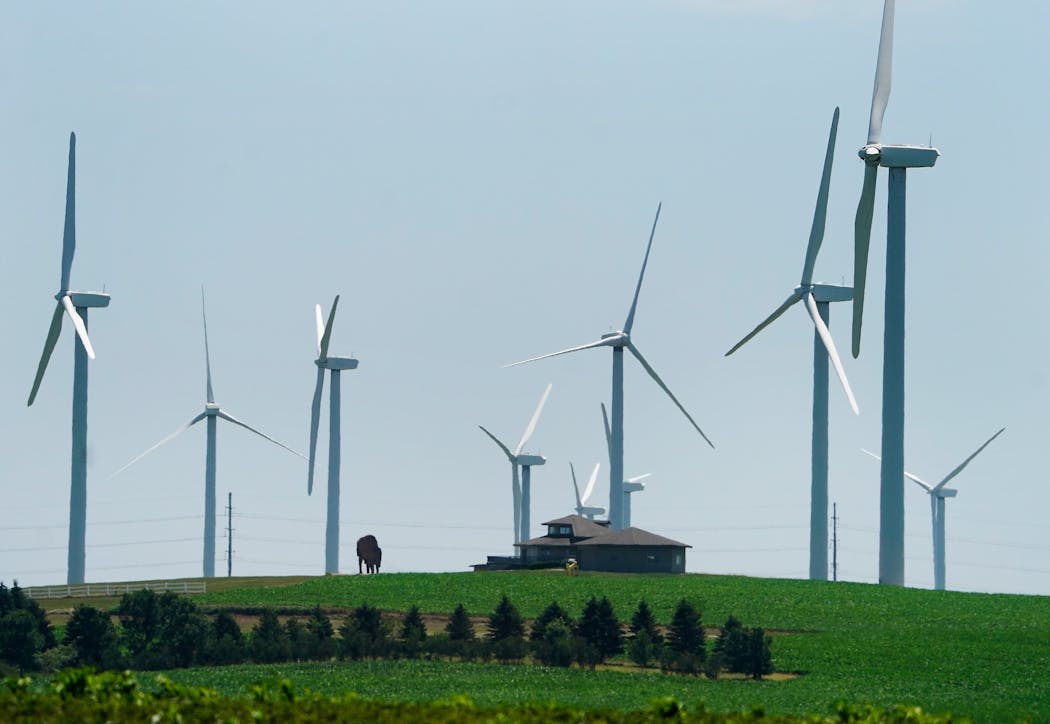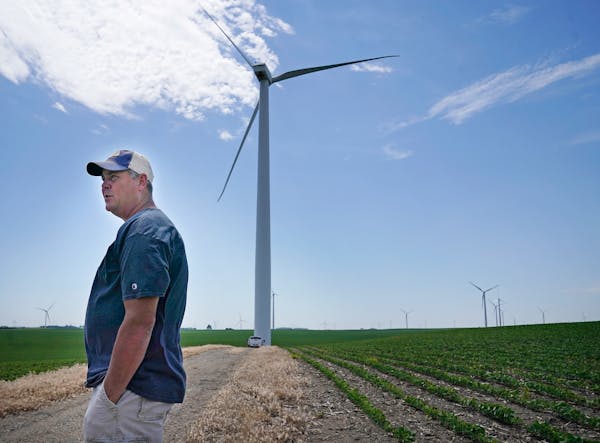MURRAY COUNTY – When a 2003-vintage wind farm in southwestern Minnesota became obsolete, its owner Allete Clean Energy tore it down and built anew.
The new Northern Wind project came online last month with bigger turbines that produce 32% more electricity than the old facility. The new turbines scoop up so much more wind that Allete needed to erect only 37 of them.
There's only one snag: Most of the blades from those 65 old turbines were cut into chunks and are now interred in a Minnesota landfill.
"We explored different options for blade recycling," said Kris Spenningsby, Allete Clean Energy's director of customer solutions and asset optimization. "But we found that the logistics and shipping were cost-prohibitive."
It's a problem the wind industry is grappling with across the country as more turbines are reaching retirement. Wind blades are made of tough-to-reuse fiberglass and plastics — and the blade recycling business is in its infancy. Most blades are dumped in landfills, studies indicate.
"The challenge [with blades] is that you have very large objects that have been designed to last for decades in all sorts of weather, so they are tough," said Aubryn Cooperman, an engineering analyst at the National Renewable Energy Laboratory. "They are hard to take apart, and the material does not have a very high value."
A 2021 study led by Cooperman found that "more profound shifts in recycling technologies, blade materials or policy may be needed to move to a circular economy for wind turbine blades."
In a circular economy, old stuff is reused, refurbished or recycled as much as possible.
Nationally, 235,000 wind blades will be decommissioned by 2050, based on a 20-year turbine lifetime, the NREL study said.
In parts of the country — including Minnesota — some wind farms are being replaced well before their 20- to 25-year expiration date, accelerating the flow of blade waste. Federal tax subsidies for wind farms have helped fuel that trend.
Move away from carbon fuels changes
The rise of wind power has been crucial in reducing carbon dioxide emissions and tackling climate change. Minnesota has been a leader in deploying wind turbines, and wind accounted for 21% of the state's electricity generation in 2021.
Minnesota's cumulative wind power capacity grew from 107 megawatts in 1998 to nearly 4,600 megawatts by 2021's close, according to the Minnesota Department of Commerce. All that wind power came from 3,959 turbines (each with three blades).
The state's earliest turbines are antiquated — like the ones replaced by Northern Wind. To make way for that project, old towers — and the turbines atop them — were felled where they stood in farm fields.
Allete Clean Energy recycled 90% of the old wind farm's components, Spenningsby said, a bit higher than the oft-cited 85% industry average.
There's a strong recycling market for wind towers, which are made of steel. Old turbine transformers can be easily resold. The old towers' concrete foundations are mostly recyclable, too.
A handful of Northern's old blades were reused at other wind farms operated by Allete Clean Energy, a subsidiary of Duluth-based Allete Corp., which also owns Minnesota Power. It junked the rest.
Allete Clean Energy will be selling Northern Wind to Minneapolis-based Xcel, along with another small wind farm, for $215 million.
Xcel is repowering four of its own wind farms — three in Minnesota, one in North Dakota. Minnesota utility regulators approved the $750 million project in December 2020, despite opposition from the Commerce Department, which questioned its benefits to Xcel ratepayers.
In Xcel's four remodeling projects, the old steel towers will remain standing and be topped with new blades and hubs, as well as new driveshafts or completely new nacelles, which house the turbine machinery. Between the four sites, about 1,200 blades will be replaced.
Pace of repowering quickening
Xcel's first repowering — at the Nobles Wind farm in Nobles County — was completed last month. The used blades were shipped to Missouri to be recycled by Veolia, a French company, Xcel said.
"They are kind of at the cutting edge now in recycling wind blades," said Jeff West, Xcel's senior director for environmental services.
General Electric, which sold Xcel the new blades for Nobles, has a relationship with Veolia. The turbine manufacturer, as part of its contract with the utility, also takes cares of blade disposal, though Xcel ultimately foots the bill.
"Reclamation is the first option and the preferred option, but they can landfill if they need to," West said.
When landfilled, the old blades — which are nontoxic — are treated as construction waste.
Recycling is expensive, costing three to eight times more than simply carting blades to landfills, West said. Also, "there is a very limited market for [recycling] right now. We expect the market to get better as other companies get into it."
The economics for recycling are penciled out for Nobles' repowering and for another Xcel project in Mower County slated to come online early next year. Two more projects are still in design and engineering states.
Transporting chunks of wind blades to the nation's handful of wind-related recycling centers is expensive. Recycling economics are hindered, too, by the low value of the material generated by the recycling process.
Fortunately, the cement industry has found a use for old blades.
At Veolia's recycling center in Missouri, blades are ground to dust and shipped to cement plants around the country. The stuff is burned in kilns, partly supplanting coal as a fuel and lowering cement makers' carbon dioxide emissions.
The ashes are used as a partial substitute for limestone, a key ingredient in cement making.
Old wind blades have also been repurposed into playground equipment and pedestrian bridges, though such markets are small.
Meanwhile, researchers are looking to improve methods for blade recycling. And wind turbine manufacturers are working to make blades with new materials that will make them more recyclable.
Repowerings before their time
None of the four wind farms being repowered by Xcel are at the end of their lifespans. One was built in 2008; another in 2010; and two in 2015.
The repowered facilities will produce more electricity, though not at the magnitude of the Northern Wind repowering. Xcel's remodeling of the two seven-year-old wind farms will increase electricity output at each by 10%.
"The technology is advancing so fast, it made sense to repower them with more efficient turbines," said Scott Sharp, Xcel's vice president for energy supply operations.
Cooperman, of the national laboratory, said that across the country in the past five years, "there has been a wave of repowerings with blades coming down sooner than their design life," driven partly by federal tax credits. Xcel is using the credits on its repowerings.
"From the waste perspective, you are generating waste sooner than you need to," Cooperman said. "You have gotten rid of a product that is still good."
Still, she added, "if you look at it from a broader clean energy perspective, you are able to get more electricity production with a relatively small input — replacing blades."
New York City turns to AI-powered scanners in push to keep guns out of the subway system
North Carolina regulators says nonprofit run by lieutenant governor's wife owes the state $132K



